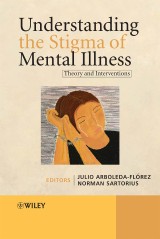Details

Understanding the Stigma of Mental Illness
Theory and Interventions1. Aufl.
|
127,99 € |
|
| Verlag: | Wiley |
| Format: | |
| Veröffentl.: | 15.09.2008 |
| ISBN/EAN: | 9780470997635 |
| Sprache: | englisch |
| Anzahl Seiten: | 232 |
DRM-geschütztes eBook, Sie benötigen z.B. Adobe Digital Editions und eine Adobe ID zum Lesen.
Beschreibungen
<p>Many mentally ill people are the victims of stigma, which leads to additional suffering and humiliation. Negative stereotypes and prejudicial attitudes against them are often reinforced by their media representation as unpredictable, violent and dangerous. Hence the importance of the study of stigma as an explanatory construct of much that transpires in the management of the mentally ill in our societies.</p> <p>This book describes the experience of stigmatization at the level of the individual, and seeks to measure stigma and discrimination from the following perspectives: Self imposed stigma due to shame, guilt and low self esteem; Socially imposed stigma due to social stereotyping and prejudice; and Structurally imposed stigma, caused by policies, practices, and laws that discriminate against the mentally ill.</p> <p>This book briefly describes programmes that aim to reduce such stigma then looks at ways to evaluate their effectiveness. It is the first book to focus on evaluation and research methodologies in stigma and mental health. It also:</p> <ul> <li>presents new interventions to reduce stigma</li> <li>describes the various international programmes which help reduce stigma</li> <li>discusses the use of the internet as an international tool to promote awareness of stigma in mental health</li> </ul> <p><i>Understanding the Stigma of Mental Illness</i> is essential reading for clinicians and researchers who wish to apply or develop stigma reduction programmes. It is also a valuable addition to the libraries of political analysts, policy makers, clinicians, researchers, and all those interested in how to approach and measure this distressing social phenomenon.</p>
<p>List of contributors vii</p> <p>Foreword ix</p> <p>Preface xi</p> <p>1 The rights of a powerless legion 1<br /><i>Julio Arboleda-Flórez</i></p> <p>2 Cross-cultural aspects of the stigma of mental illness 19<br /><i>Bernice A. Pescosolido, Sigrun Olafsdottir, Jack K. Martin and J. Scott Long</i></p> <p>3 The WPA Global Programme against Stigma and Discrimination because of Schizophrenia 37<br /><i>Norman Sartorius</i></p> <p>4 ‘Fighting stigma and discrimination because of schizophenia – Open the Doors’: a collaborative review of the experience from the German project centres 49<br /><i>A.E. Baumann, W. Gaebel, et al.</i></p> <p>5 Stigma and health care staff 69<br /><i>Juan J. López-Ibor Jr., Olga Cuenca and María-Inés López-Ibor</i></p> <p>6 Evaluating programmatic needs concerning the stigma of mental illness 85<br /><i>Beate Schulze</i></p> <p>7 Using the Internet for fighting the stigma of schizophrenia 125<br /><i>Hugh Schulze</i></p> <p>8 Building an evidence base for anti-stigma programming 135<br /><i>Heather Stuart</i></p> <p>9 Other people stigmatize . . . but, what about us? Attitudes of mental health professionals towards patients with schizophrenia 147<br /><i>Alp Üçok</i></p> <p>10 Implementing anti stigma programmes in Boulder, Colorado and Calgary, Alberta 161<br /><i>Richard Warner</i></p> <p>11 Stigma measurement approaches: conceptual origins and current applications 175<br /><i>Lawrence H. Yang, Bruce G. Link and Jo C. Phelan</i></p> <p>Appendix Inventories to measure the scope and impact of stigma experiences from the perspective of those who are stigmatized – consumer and family versions 193<br /><i>Heather Stuart, Michelle Koller and Roumen Milev</i></p> <p>Index 205</p>
“This book does not try to argue against the reality of mental illness, but rather to understand and combat the stigma associated with it. The result is a balance of textbook and manual. It is provides an in-depth account of the contemporary debate, and effectiveness, efficiency and efficacy as well as measurement are key issues, and ideas and works in progress that fledgling programs could find of great use. If someone is looking for a presentation of some of the best available evidence, and thoughtful, careful descriptions of anti-stigma programs, it is essential reading. It will provide guidance and resources, it is thoroughly referenced and gives dozens of leads that people will want to follow … .It is of equal value to metal health professionals, non-government organizations and partners in health literacy such as schools and advocacy groups. It makes a substantial contribution to the literature and is highly recommended.” (<i>Metapsychology</i>, November 2008)
Many mentally ill people are the victims of stigma, which leads to additional suffering and humiliation. Negative stereotypes and prejudicial attitudes against them are often reinforced by their media representation as unpredictable, violent and dangerous. Hence the importance of the study of stigma as an explanatory construct of much that transpires in the management of the mentally ill in our societies. <p>This book describes the experience of stigmatization at the level of the individual, and seeks to measure stigma and discrimination from the following perspectives: <b>Self imposed stigma</b> due to shame, guilt and low self esteem; <b>Socially imposed stigma</b> due to social stereotyping and prejudice; and <b>Structurally imposed stigma</b>, caused by policies, practices, and laws that discriminate against the mentally ill.</p> <p>This book briefly describes programmes that aim to reduce such stigma then looks at ways to evaluate their effectiveness. It is the first book to focus on evaluation and research methodologies in stigma and mental health. It also:</p> <p>● presents new interventions to reduce stigma</p> <p>● describes the various international programmes which help reduce stigma</p> <p>● discusses the use of the internet as an international tool to promote awareness of stigma in mental health.</p> <p><b><i>Understanding the Stigma of Mental Illness</i></b> is essential reading for clinicians and researchers who wish to apply or develop stigma reduction programmes. It is also a valuable addition to the libraries of political analysts, policy makers, clinicians, researchers, and all those interested in how to approach and measure this distressing social phenomenon.</p>


















